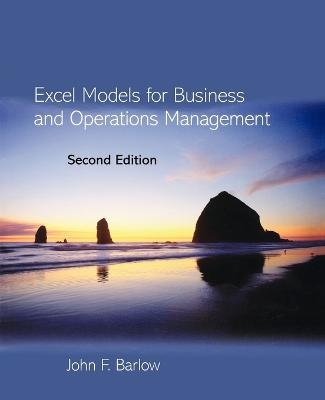
Excel Models for Business and Operations Management
John Wiley & Sons Inc (Verlag)
978-0-470-01509-4 (ISBN)
The popularity of spreadsheets in both business and academia has increased considerably over the past five years. This new edition of a successful textbook will be thoroughly updated to reflect changing practices and technology. This text adopts an active learning approach with the emphasis being placed on the utilization of software tools to help build models. The book’s primary approach is to help the reader put theory into practice. The ‘learn by example’ approach used throughout the book guides the user through the complexities of model building. Every day examples from business and operations management form the basis of the book’s ‘hands on’ development models that help the reader to appreciate Excel’s power and flexibility.
Dr Barlow holds degrees in mathematics, computer science, and mechanical engineering. As well as extensive teaching experience – previously at the Universities of Cape Town, South Africa and Wollongong, Australia – he has held various positions in computer consultancy and the petroleum industry. He has published numerous papers in the areas of computer applications and systems management.
Preface xiii
1 A systems view of business 1
Overview 1
A systems view of business operations 2
A manufacturing business model 3
Finance and cost accounting 3
The marketing function 5
The production function 5
Management decision-making 12
Enterprise resource planning (ERP) 15
References and further reading 16
2 Model-building tools 17
Overview 17
Modelling characteristics 18
Risk and uncertainty in decision-making 20
Linear programming (LP) 21
Using Excel’s ‘Analysis ToolPak’ 26
Statistical methods 27
Decision analysis 34
Simulation 42
Excel functions used in model-building 46
Exercises 49
References and further reading 51
Part 1 Business Models 53
3 Financial models 55
Overview 55
Financial statements 56
Ratio analysis 56
Net present value (NPV) 59
Investment appraisal 61
Portfolio management 64
Capital budgeting using decision trees 68
Cash flow analysis 69
Investment financing: a simulation model 74
Financial planning 78
Commercial add-in products for Excel 82
Excel functions used in model-building 82
Exercises 86
References and further reading 88
4 Investment analysis models 89
Overview 89
Risk preference attitudes 90
Utility theory 91
Portfolio theory: the Markowitz model 94
Portfolio analysis: the efficient frontier 97
Single index model (SIM) 101
The capital asset pricing model (CAPM) 106
Bond valuation 108
Duration and bond volatility 113
The Black–Scholes option pricing model 117
Excel functions used in model-building 120
Exercises 124
References and further reading 126
5 Worksheet applications in cost accounting 127
Overview 127
Cost-volume-profit analysis 128
Depreciation 130
Equipment replacement 132
Statistical replacement analysis 136
Simulation model for replacement/repairs 140
Comparison between simulation and statistical results 144
Budgeting 144
Job costing 150
The learning curve 155
Checking the accuracy of learning curves 158
Excel functions used in model-building 160
Exercises 163
References and further reading 166
6 Marketing models 167
Overview 167
Organising and presenting data 167
Correlation analysis and linear regression 170
Forecasting – time series and exponential smoothing 174
Forecasting – exponential smoothing 178
Salesforce models 186
Goal programming 190
Excel functions used in model-building 200
Exercises 201
References and further reading 205
7 Purchase order processing: a database application 206
Overview 206
Creating a simple macro 207
Purchase order processing 209
Creating the title screen 210
Products and suppliers worksheets 214
Creating the purchase order form 215
Creating the database and its associated macros 219
Macros for transferring data into the database 221
Adding macros to buttons 224
Amending purchase orders 225
Printing purchase orders 230
Protecting the POP database application 232
Excel functions used in model-building 236
Exercises 237
References and further reading 239
Part 2 Models for Operations Management 241
8 Statistical applications in quality control 243
Overview 243
Probability distributions 244
Acceptance sampling 249
Estimation – drawing conclusions from samples 253
Hypothesis testing – checking out a claim! 257
Analysis of variance (ANOVA) 258
Statistical process control 263
Excel functions used in model-building 272
Exercises 275
References and further reading 278
9 Inventory control models 279
Overview 279
Glossary of inventory terms 280
Characteristics of inventory models 281
Deterministic models 282
Production order quantity model 284
Inventory models with constraints 291
Probabilistic models 293
Inventory control: a simulation approach 304
Material requirements planning 307
Lot-sizing methods 315
Just-in-time (JIT) approach to inventory management 318
Excel functions used in model-building 318
Exercises 319
References and further reading 323
10 Models for production operations 324
Overview 324
Logistics models 325
Other network flow applications 331
Production planning and scheduling 339
Queuing models 353
Excel functions used in model-building 362
Exercises 364
References and further reading 369
11 Project management 370
Overview 370
Project management techniques 371
The project network 371
Simulation model for project management 392
Exercises 396
References and further reading 399
Appendix Excel refresher notes 400
Basic Excel commands 400
Drawing charts with ChartWizard 405
Object linking and embedding (OLE) 407
Index 409
| Erscheint lt. Verlag | 7.6.2005 |
|---|---|
| Verlagsort | New York |
| Sprache | englisch |
| Maße | 192 x 238 mm |
| Gewicht | 765 g |
| Themenwelt | Wirtschaft ► Betriebswirtschaft / Management |
| ISBN-10 | 0-470-01509-8 / 0470015098 |
| ISBN-13 | 978-0-470-01509-4 / 9780470015094 |
| Zustand | Neuware |
| Informationen gemäß Produktsicherheitsverordnung (GPSR) | |
| Haben Sie eine Frage zum Produkt? |
aus dem Bereich


